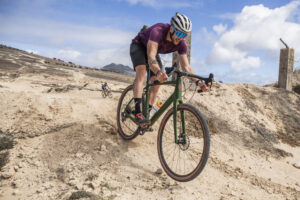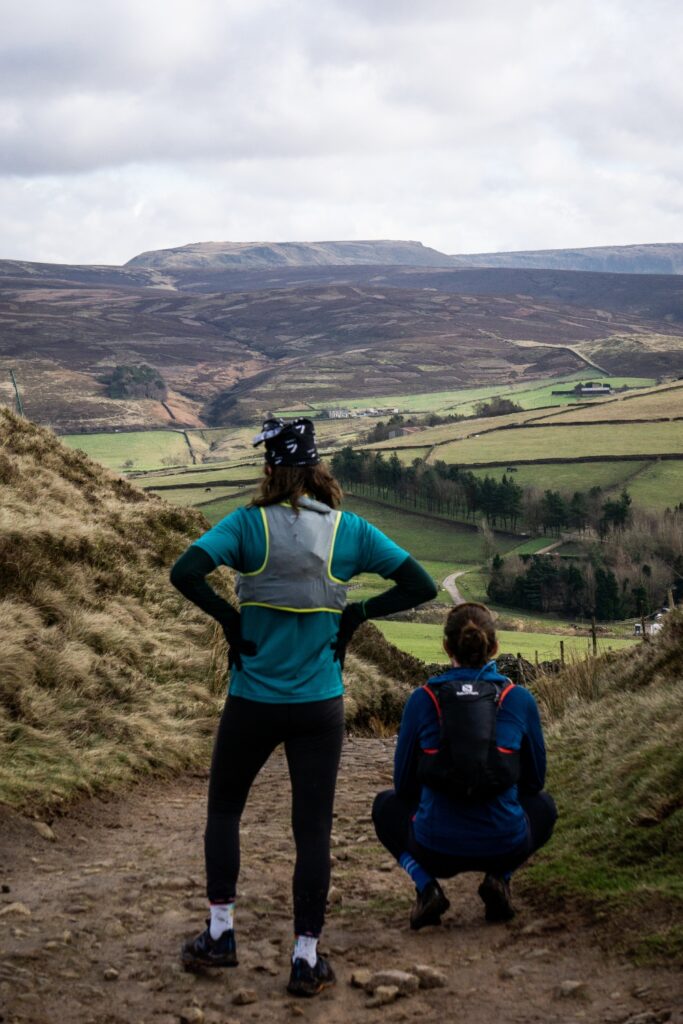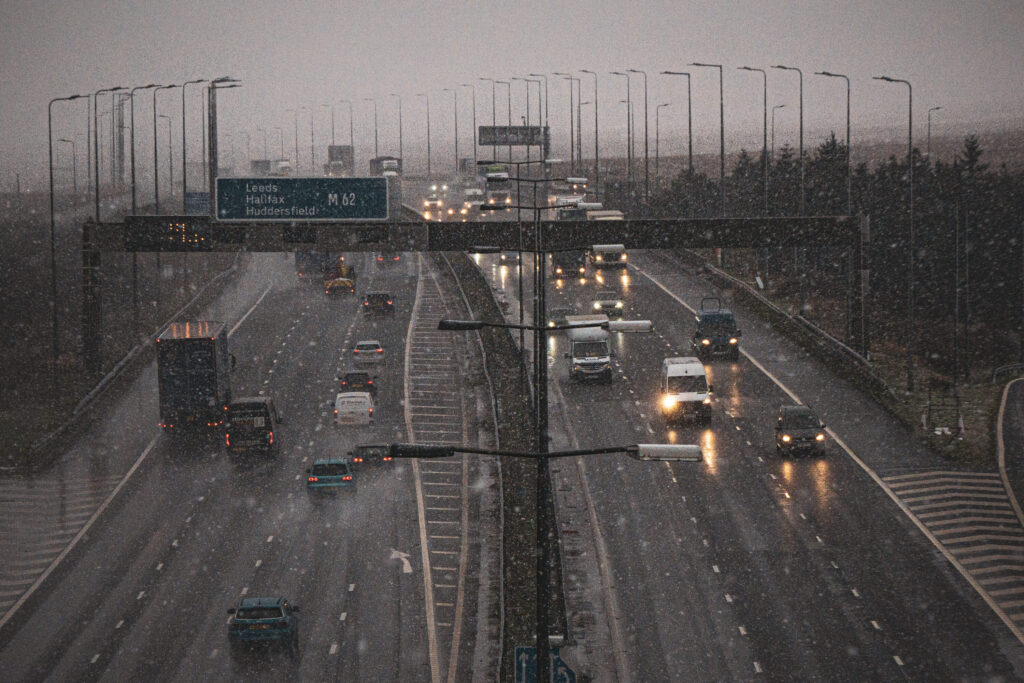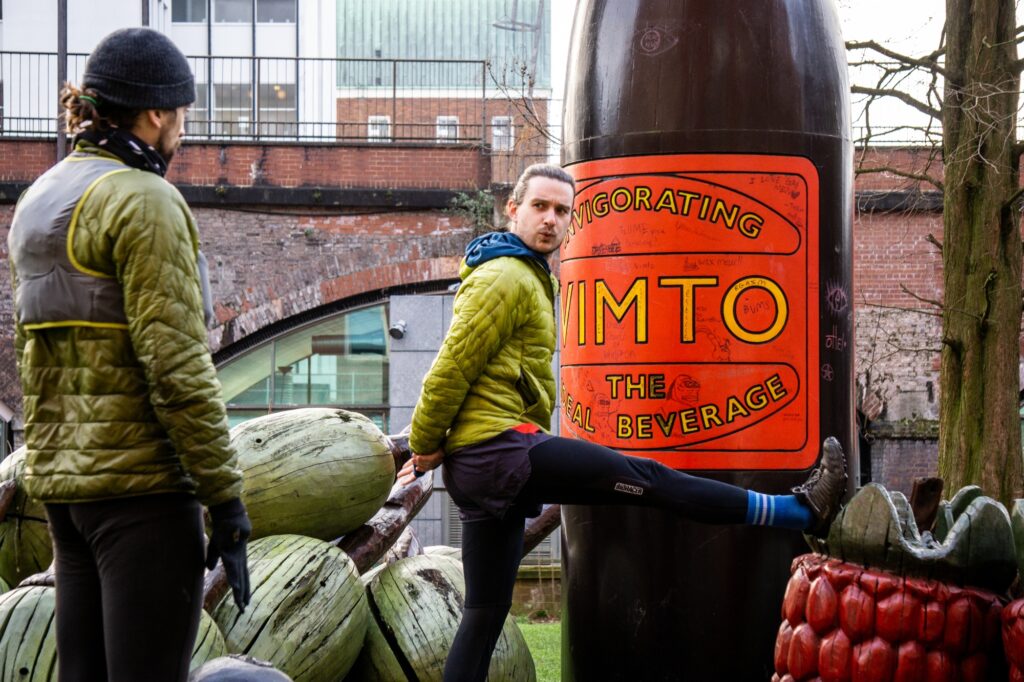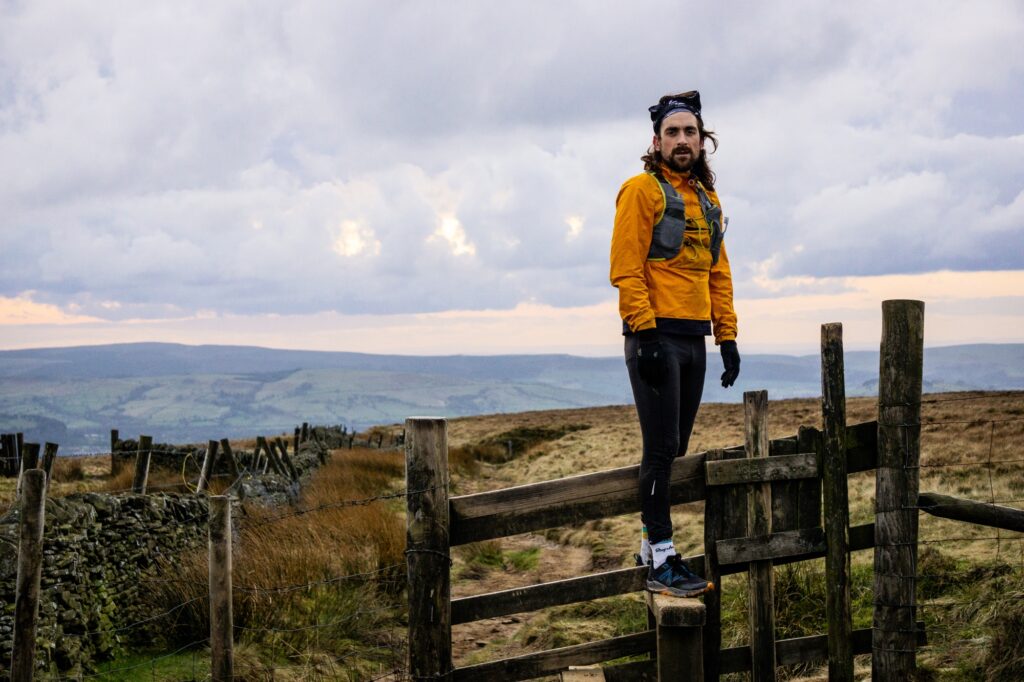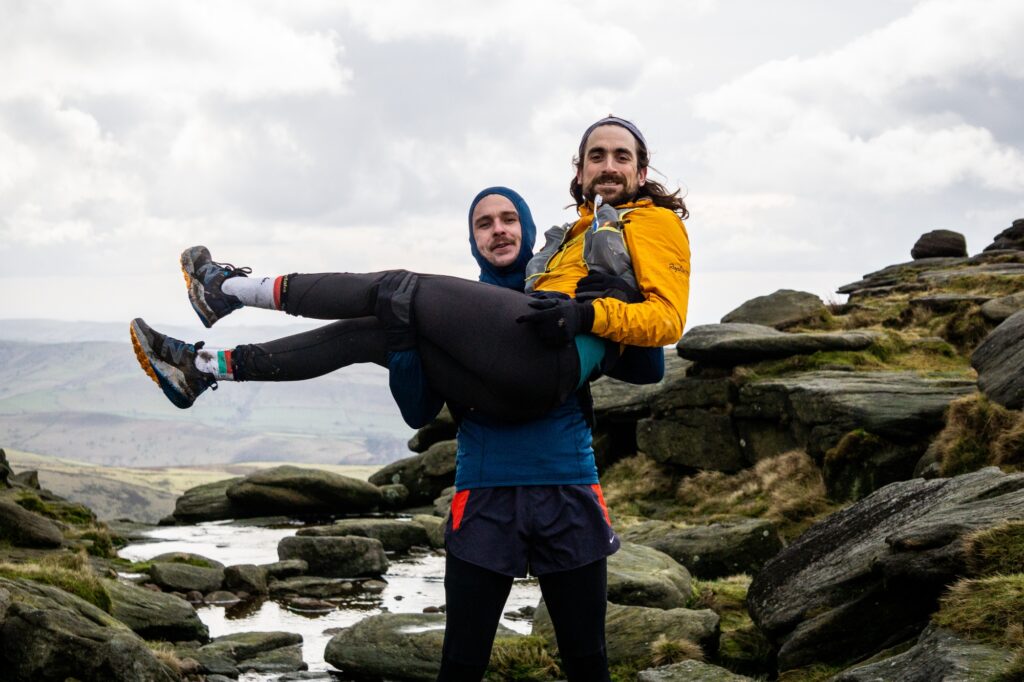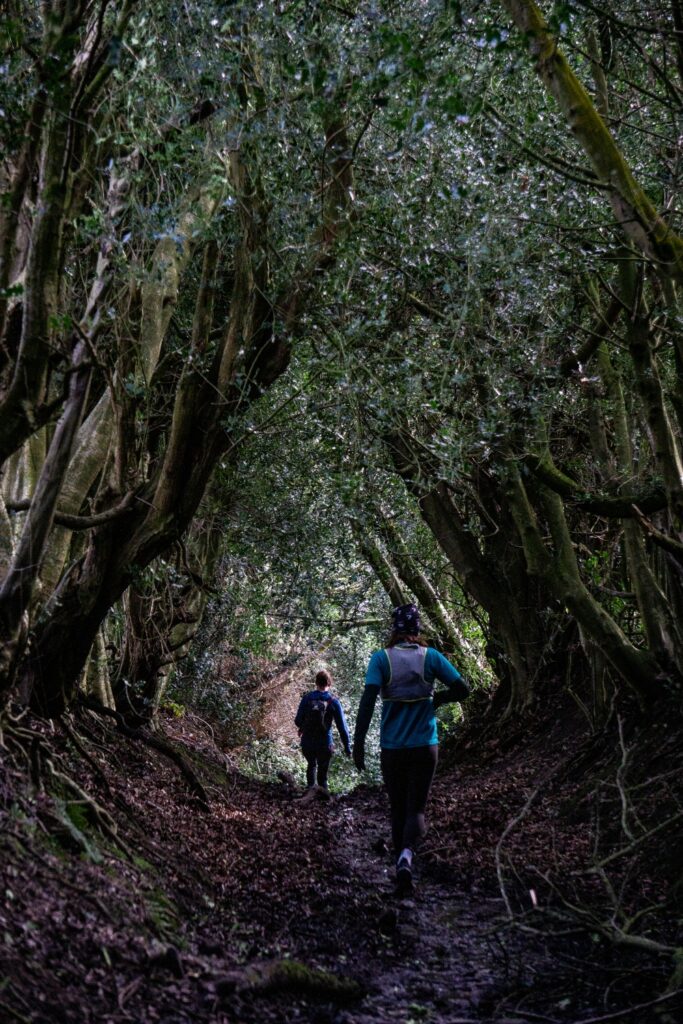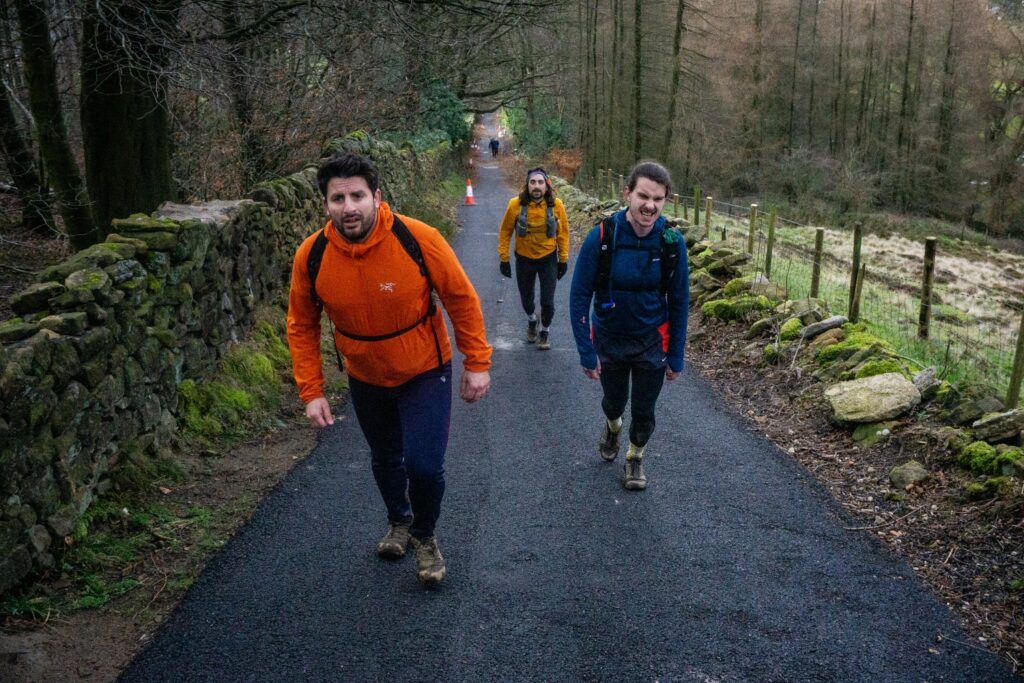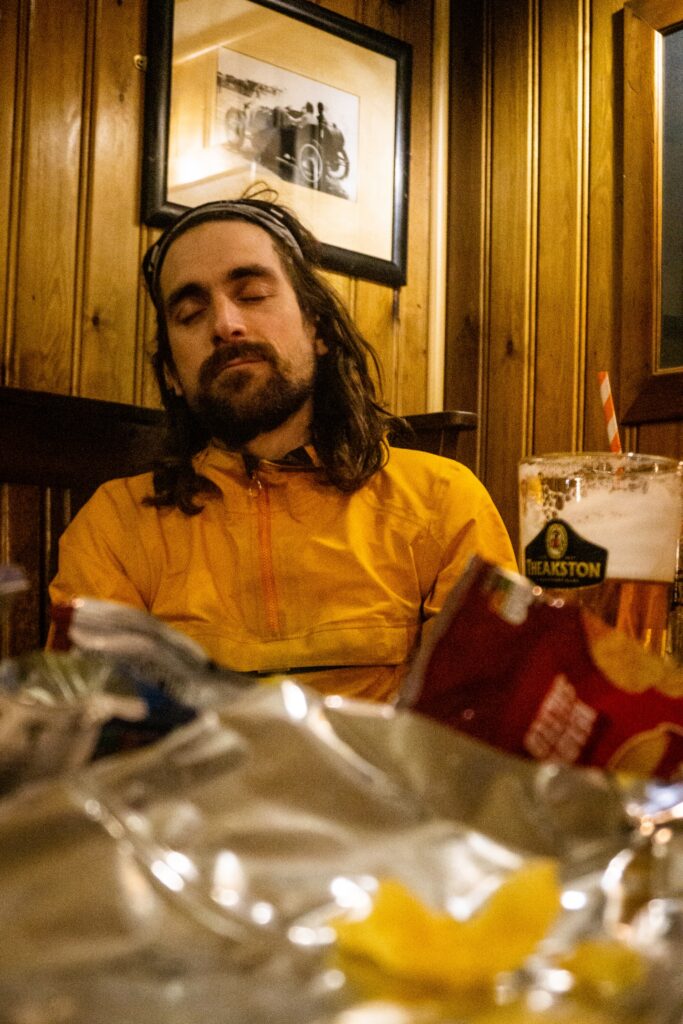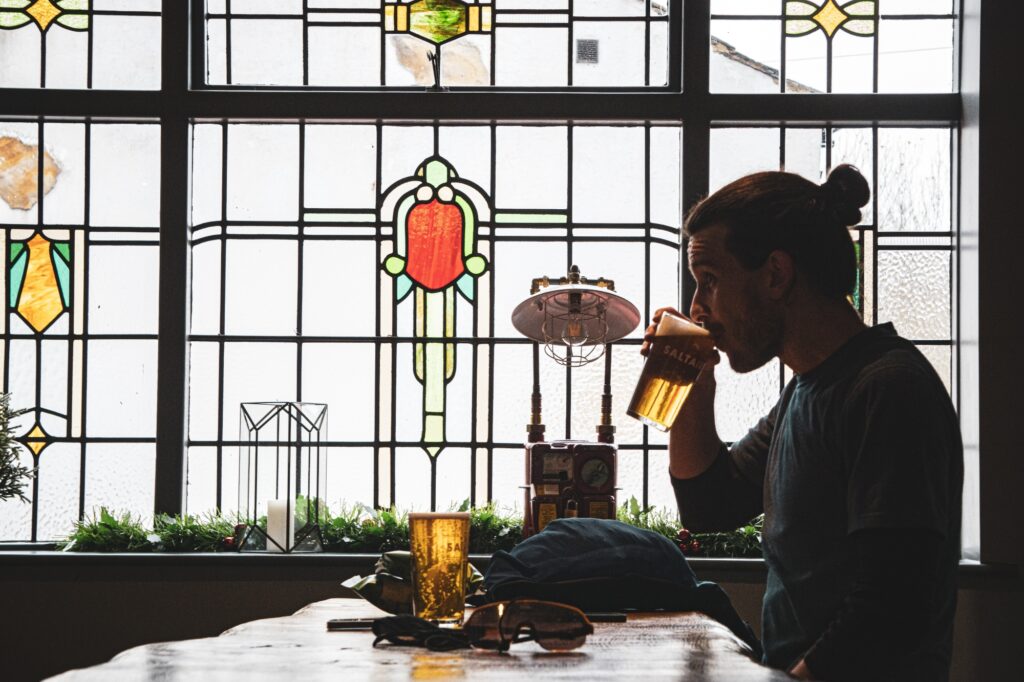The simple act of placing one foot in front of the other is the most rudimental of human movement. With minimal kit requirement and infinite opportunity, altering the speed dial and injecting a touch of both creativity and curiosity can form the framework for the most accessible of adventures. Exploring running as more than sport, Tom Hill recounts his trail running experiences close to his home in the Pennine Hills and lays out the groundwork for how you can take the step into more adventurous running of your own.
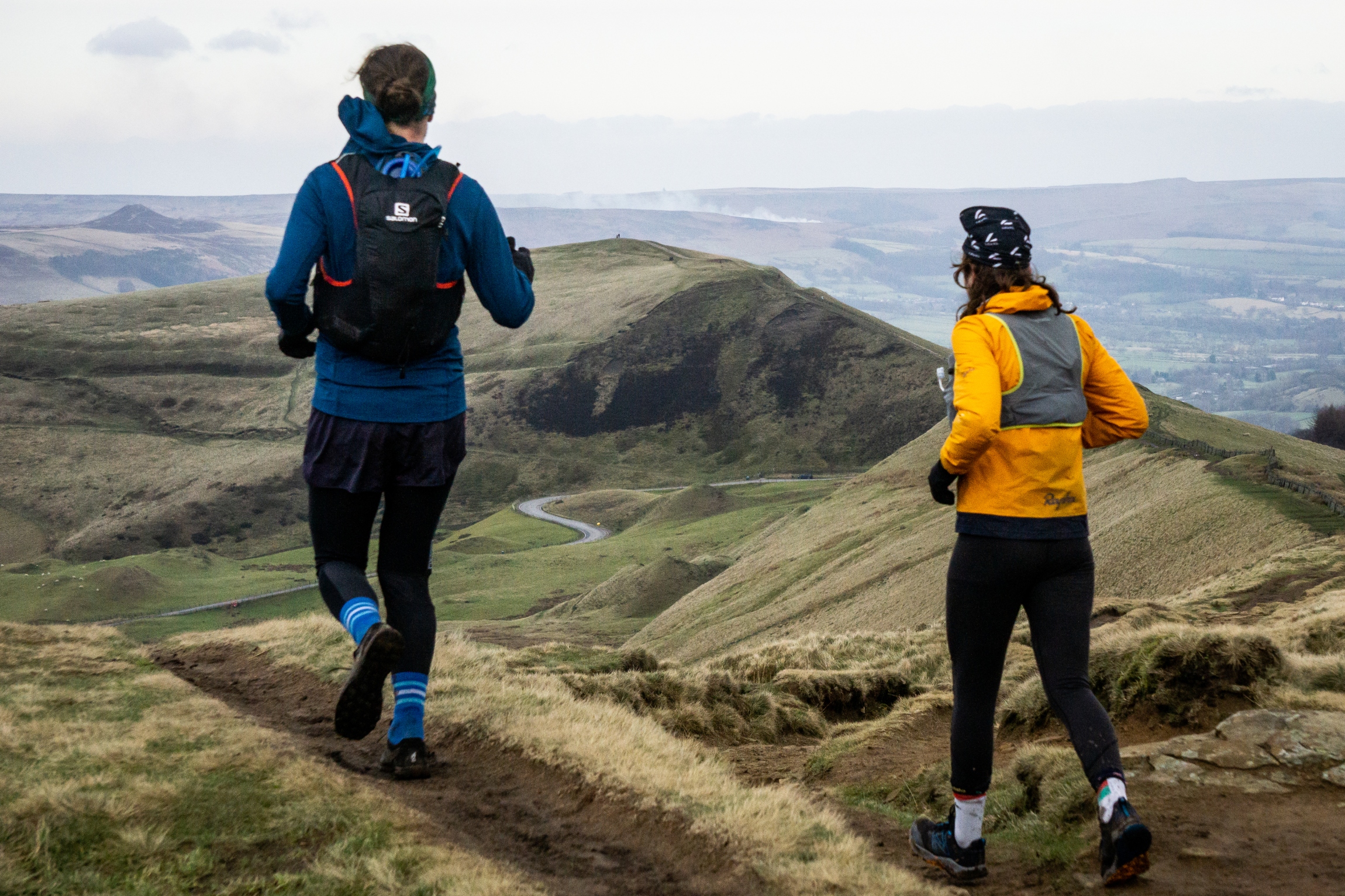
All downhill from here.
My tired eyes met themselves as I stared through the train window. The last vestiges of light for the day were fading without the glory of a sunset. Squinting beyond the jarringly bright reflections of the train interior, and above the softer orange glow of street lamps, my view was one of dingy, silhouetted Pennine hills. Even in the half-light of a winter dusk it was possible to make out the snow-blanketed tops of the moors, and a perfect gradient of mushroom greys, framed by dry-stone walls, whitened by the prevailing westerly storm and somehow even blacker than the creeping night on the leewards side.
I had most of the carriage to myself, and casting my eyes down I realised it was probably for the best. A stream of peaty water trickled from my running shoes, mud clung to my running tights, the left leg of which was steaming as I rested it against the train’s heater.
I’d run further than I normally would in a day, but not ultra-distances, yet I felt like I’d been on a true journey through lands just out of touching distance if I were entirely under my own steam. I had reawoken a sense of adventure, and spent a whole day traversing snow-covered ground, without seeing a single other soul. Not bad for a Tuesday in early December.
I set the alarm on my phone as I nestled my head into my down jacket and against the window. I closed my eyes as the train rattled eastwards to home.
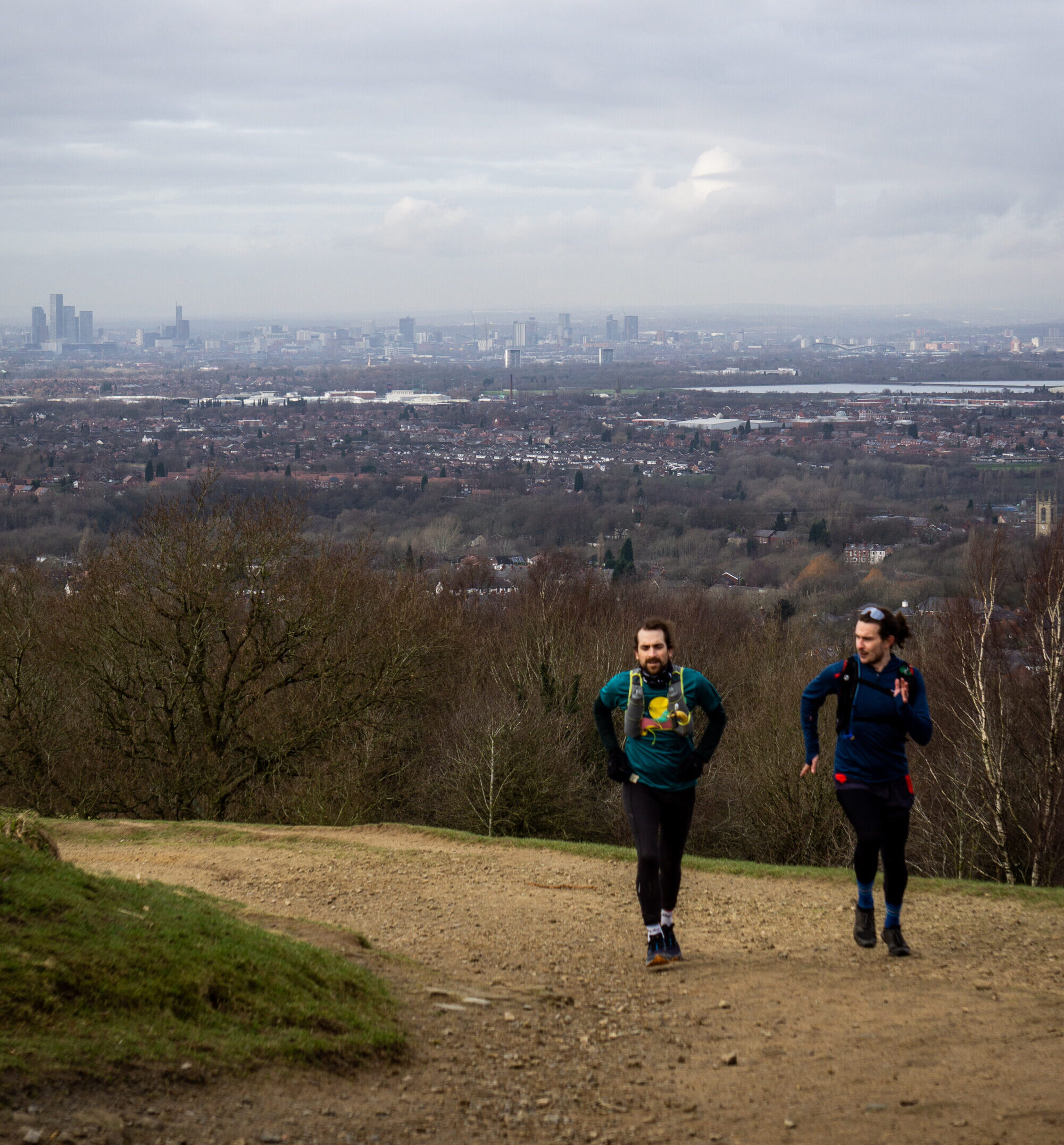
The Manchester skyline slowly recedes as we make our way east.
This isn’t a story about running. It is a manifesto for looking at the act of moving a little faster than walking pace in a different way
Before I go on, this is not a story about epic miles or incredible speed. In fact, this isn’t a story about running. It is a manifesto for looking at the act of moving a little faster than walking pace in a different way; a mode of transport, a tool for travel, an opportunity for adventure rather than the simple aerobic exercise that it is all too often stripped down to.
Running has been part of my life, well, for as long as walking. In that time, my relationship with it has ebbed and flowed, intensified and all but vanished. I have worked my way through distances to the point that they didn’t matter, obsessed over races and times. I have run-commuted with a rucksack loaded up with a laptop and a change of clothes simply to get the miles in. And I have stared at my running shoes sitting on the rack – knowing how much better I would feel for just getting outside – but have somehow failed to make that first hardest step of lacing them up and opening the front door.
It has taken me a long time to work out what drives me to run, beyond the sheer love of its simple purity and the sense of flow that I get on the very best of running days. I’m still pondering and analysing, but in the last few years, I have realised that what drives me in a much wider sense is purpose and adventure. Racing was a purpose; it was a reason to train on the days I didn’t feel like it, and ultimately there’s no such thing as a bad run. Yet, I reached a point that racing no longer really felt like an adventure. How could I replicate all the great things about racing, but decouple it from the elements I didn’t enjoy, like competition, my own performance expectations and – most importantly – the limitations of following a set route on a set day?
It had already felt like a long winter, and I needed something to extract me from a funk. I needed a new purpose to run; a new adventure. I’m not even sure where I heard of the Stanza Stones, but one of my regular riding loops passes one of the six pieces of gritstone, each engraved with a poem dedicated to the elements. They are spread out across a fifty mile stretch of the Pennine moors, from Marsden in the south to Ilkley in the north. My winter-softened legs and mind couldn’t face linking them together in a single day, but maybe multiple days would be possible. In the end I settled on three runs, spread across three weeks, each using trains to transport me to start and finish points.
Which takes us back to where we began. A train from Hebden Bridge back to my home in Bradford, a bookmark in a longer story; one to be returned to. Seven days later, I opened the book again, cracked the spine and retraced my public-transport journey to the Calder Valley. What was the end became the beginning. The route was one of exotic homeliness; a sense of familiarity within the wider landscapes and place names. Everything from the colour of the rock to the shape of the hills felt so intimately known that they are part of me, despite never having trod sections of the route. Then there were locations or trails that I had visited before and forgotten about, others that I had reached from another direction, surprised as if I had bumped into an old friend in the pub. What are you doing here?
From Colne to Calder to Aire to Wharfe, I crossed moors before returning to the folds of dales and valleys and the towns nestled within. And at the start and end of each day my train journey was time for reflection, re-reading the poems I had absorbed on windswept moors in a degree of comfort, deliberately storing memories before they became too strung out to recall.
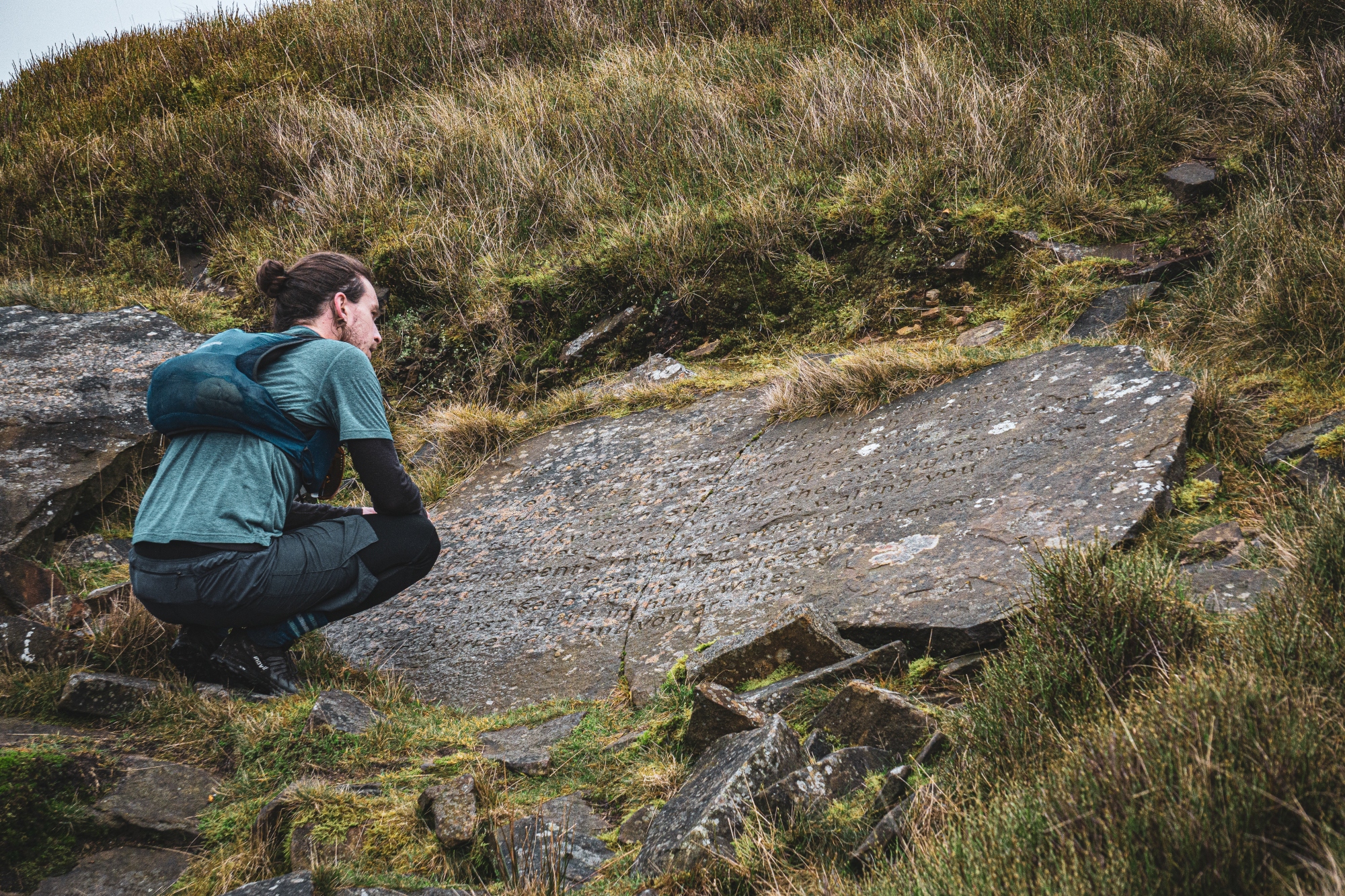
The Mist stone was tricky to find even on a clear day.
Stories of life and death; and much more important things like where we should enjoy a pint at the end and the greatest chocolate bar of all time
I started the Stanza run solo, but was joined by a pal, Luke, on the second and third legs. For the most part, my running has always been a solo endeavour; time to think, time to not think, time to move at my own pace and no one else’s. And while I will always treasure alone time in the hills and woods and even pounding the pavements of home, company brings another level to the experience.
A few weeks later, Luke and I joined another Tom in Manchester city centre. Our starting point was the somewhat arbitrary, intentionally irreverent Vimto sculpture, because why not? We had a question to answer. Which, now I think about it, is probably the best reason possible to go for a run. The poser this time was do you reckon we could trail run between Manchester and Sheffield in a couple of days?
The answer to these kinds of questions rarely matters. It’s the finding out that’s important. For what it’s worth the answer was yes this time. The route was an absolute beauty too, from the canal towpath and council estates of Manchester to the Kinder plateau. Hospitality by our buddy Stef in Castleton. Then following him the next day up Win Hill and over to the wooded corridor of the Porter Valley transporting us almost all the way to Sheffield city centre.
My lasting memory of the run – beyond even the route – is that of the conversations along the way. Shoulder-to-shoulder, open hearted, open minded discussions. Time to truly listen, and time to speak truly. Stories of life and death; and much more important things like where we should enjoy a pint at the end and the greatest chocolate bar of all time (Double Decker FYI).
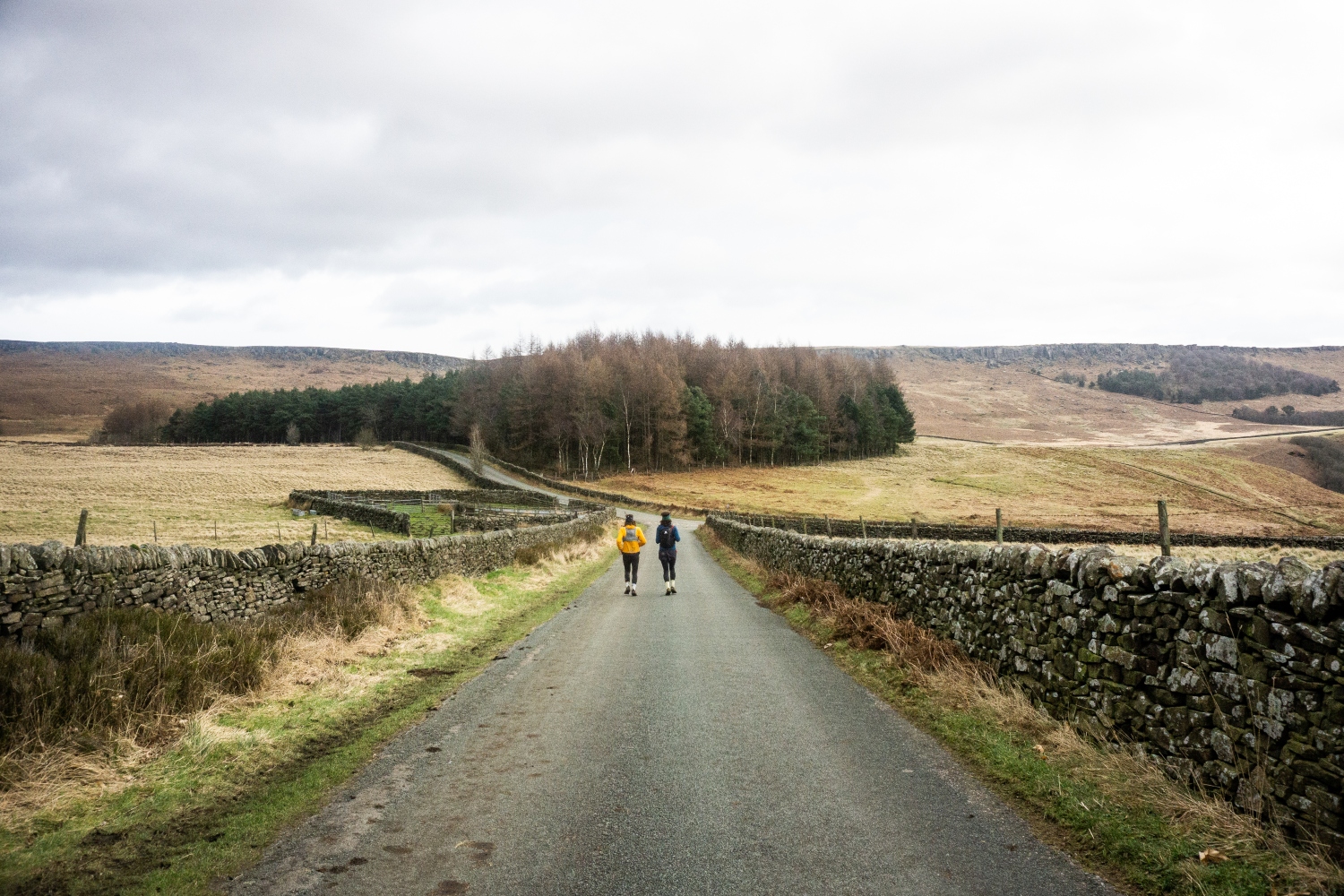
The road to Stanage Edge.
Way up there near the start, I said this story was a manifesto; a proclamation of a different way of seeing the run. There have been times where the very essence of running; the pure nature of striding out has delivered me so much joy I needed nothing else, but the greatest memories that I have taken away from running are not of the act itself. They are of the places I have visited: the glorious – no, perfect – one hundred metres of sinuous trail in my local woods; the Alpine temperature inversion at dawn, with high peaks piercing the cloud; and the glowing sign of a pub marking the end of a hard day out.
So I encourage you to, nay, plead that you… plan an adventure. One with purpose. And go and enact it. Measure that run in smiles, new views and conversations had; and I promise you will be richer for it.
The Blueprint
Inspiration
How do you find your own adventure with purpose? Well, there’s a few good starting points, but a curious mind helps. Simple questions sometimes lead to the most interesting of answers. ‘Where does that trail go?’ and ‘I wonder if I can run to there?’ have regularly ended up in some of my favourite (mis)adventures.
Inspiration for a run can come from limitless sources, but an Ordnance Survey map is always a good start. Even staring at the map of my local area, I still spot short sections of footpath that I’ve yet to tread, or weird geological features, or unusual place names that are screaming out to be visited.
I’ve also drawn inspiration from books or television; running to and through places steeped in history, following ancient paths. And on that note, there’s no harm picking up guide books or following in the footsteps of others’ routes. Don’t forget you can split longer routes up, or join shorter ones together.
Planning
I’m an old fashioned guy and struggle to plan a run on anything other than maps, but there are plenty of other tools out there. Planning apps like komoot or mapmyrun can be amazing tools for example. And a GPS line on a watch or your phone can be easier to follow than a map when you are on the move.
Multi-day
There’s something really special about a multi-day trip. Even a single night away completely changes the dynamic of the run. B&B’s, hostels, bunkhouses and hotels make for great lightweight options – bring some lightweight spare clothes and you needn’t bring anything more than you would on a day run. A small tent or a bivvy bag allows for even more adventurous running, but adds weight and the amount of kit you need.
Remember that unless you are used to back-to-back running your legs will probably feel a little fried at the start of your second day. A blister plaster or two might be a good call. And then ignore how stiff you feel for the first mile or two. There will come a point where your body resigns itself to the fact that it’s got to do this all over again and will start to cooperate.
Mindset
This ain’t a race (unless you want it to be). Walk when you want. Stop and take photos. Be curious. Leave the path and explore the woods. Clamber on rocks. Read signs. Call into the pub part way along. Stop and say hello to the people you meet. Immerse yourself in the sense of adventure.
Transport
We all have a distance that we feel comfortable running in a day. Imagine that’s ten miles. You will almost certainly know every path, trail and road within the five mile radius of your house; an invisible boundary to be touched before it’s time to make your way home. But, if you only had to run in one direction, then that boundary line doubles. Never underestimate the power of running somewhere to change the mindset of a run. A loop, well, you just end up where you started. A destination? That’s different somehow.
Pick a train station or a bus stop ten miles away and instant adventure awaits; new trails and paths through distant, but familiar lands. Then, of course, there’s no reason to limit your travel to one end of the run. Instantly the world opens up even further.
Kit
The great thing about running is the lack of kit that’s needed. For your first time doing something more adventurous than your day-to-day scampers, it’s worth spending a little time pondering gear though. What you need will obviously depend on the time of year and the exact nature of your run, but here’s a starter:
- Running shoes that are suitable for the conditions and you are used to
- A waterproof jacket
- An extra warm layer for emergencies (and to wear after if you need to travel home. I’ll sometimes also bring a spare base layer to change into as well)
- Hat and gloves
- Scran and sup: sufficient food/water for the distance. My go-tos are Haribo, Outdoor Provisions bars and nut butters and for much longer distances, a bit of real food in the form of a butty or a pie.
- A pack that is big enough to carry all of the above
- Your preferred form of navigation tool
- Cash/method of paying for travel/extra food etc
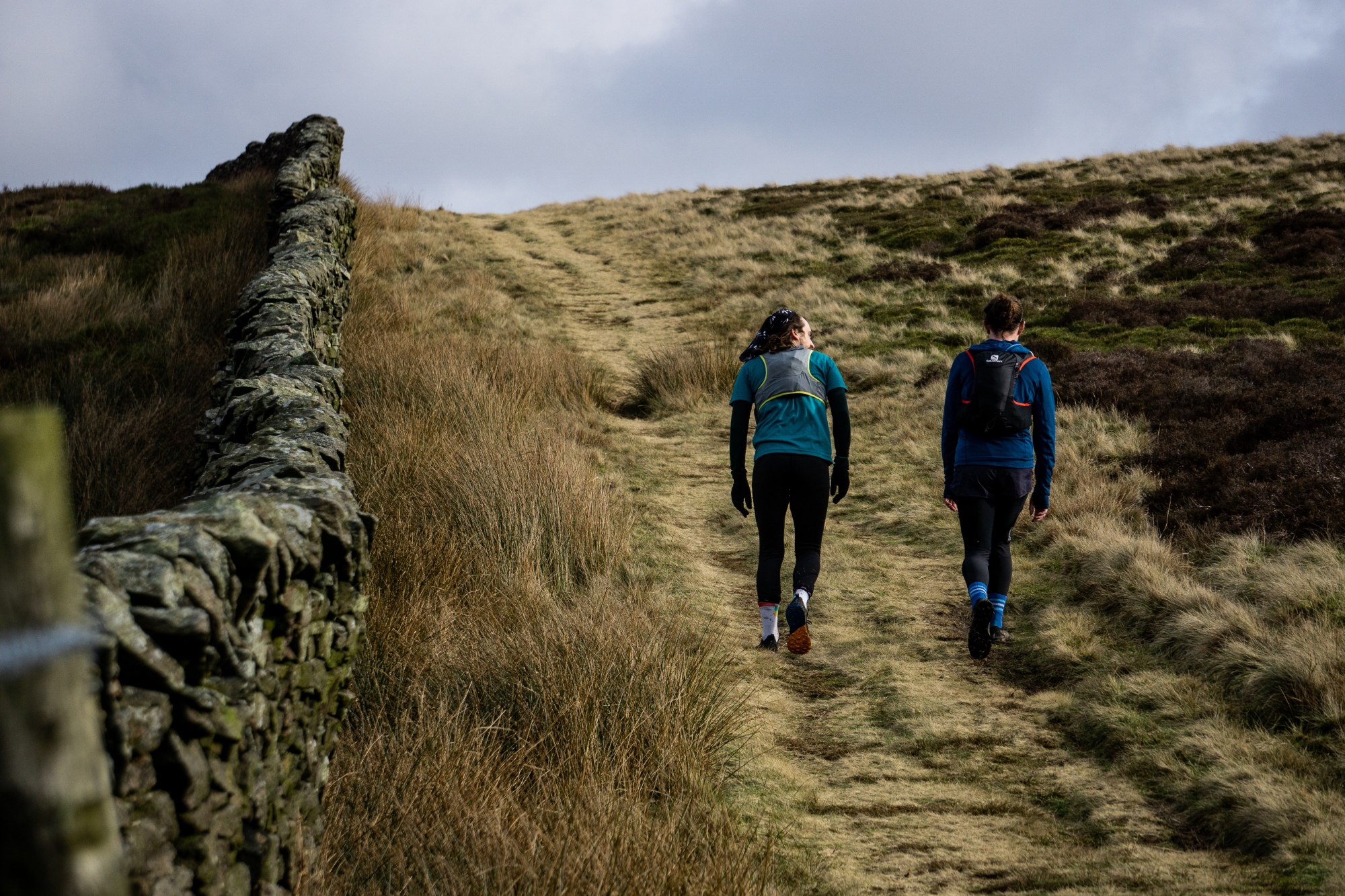
Run when you want, walk when you want.
Company
Despite it being the exception rather than the rule for me, I love running with mates. It does change the dynamic of the day though. Ideally your running partners should be of a similar level of fitness to you. If there is a big disparity, the fitter person should be prepared to walk more often and move more slowly than they are used to. It’s their role to change their pace, not the responsibility of the slower runner to try and keep up.
Having said that, there will be times where you naturally drift into your own paces. Embrace that, but regroup regularly and make sure all parties are ready to move on, not just the fastest (who has also had the longest rest).
Talk; enjoy the time out together. Share the experience… and race the last 100 metres to the pub. Last one there buys the first round.
Leave a positive trace
We all know, and all subscribe to leaving no trace… I highly doubt that anyone reading this far has ever intentionally dropped litter. But when there are thousands of careless acts committed daily, maybe we should think about how we can give back a little to the wild places and green spaces that we enjoy so much. The positive act of picking up a rogue sweet wrapper or drinks bottle takes close to zero effort and leaves the hillside in a better state than when you visited. Visit Trash Free Trails for more.
Safety
Right… the sensible bit. First of all, it’s highly unlikely that anything will go wrong. It’s even less likely that you won’t be able to get yourself out of whatever pickle you find yourself in. But, it’s worth giving yourself a fighting chance. On the first day of the Stanza run, I had to rely on a compass bearing for around 30 minutes, despite following a very broad track on the Pennine Way. It was full white-out conditions and I was wearing every scrap of clothes I had brought with me. It was joyfully wild, but it obviously had the potential to be dangerous had I got lost or decided to leave my ‘just in case’ layer at home.
It’s a lesson worth remembering any time of year; I’ve had plenty of summer mountain runs in the UK where I’ve started and finished in shorts and a vest, but been chilled to my core in multiple layers across the tops.
Make sure you know how to use whatever you use to navigate… and think about a back up. What happens if you drop your phone/your map blows away?
In short, push yourself but always have an insurance policy.
